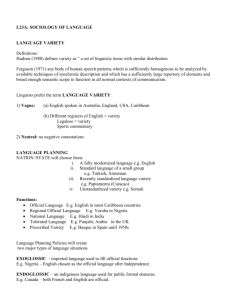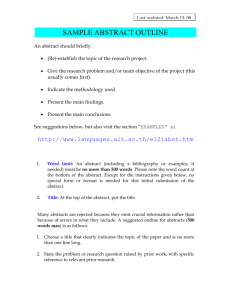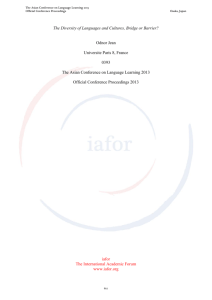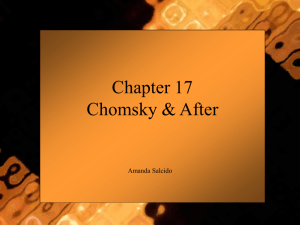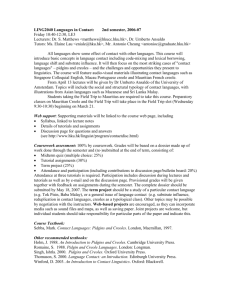Lecture 3 and 4 - California State University, Bakersfield
advertisement
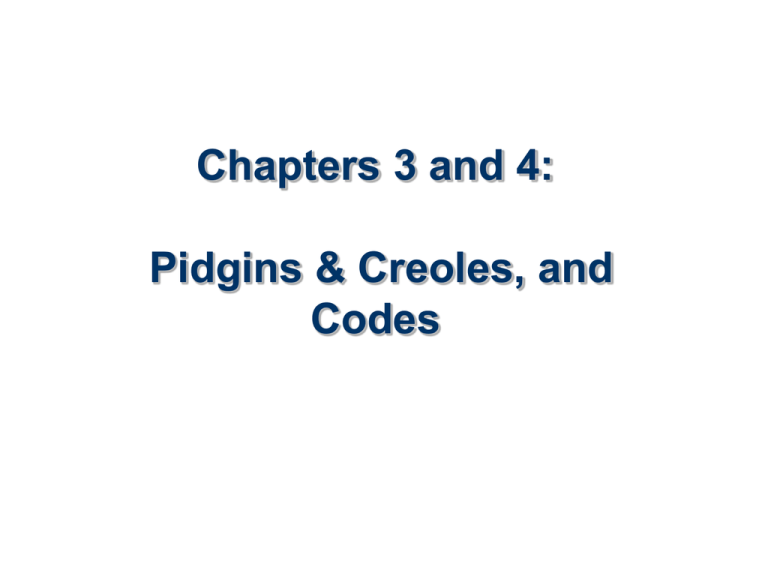
Chapters 3 and 4: Pidgins & Creoles, and Codes Outcomes of Language Contact Language Death: no native speakers Language Shift: One language replaces another Language Maintenance: A relatively stable bi-/ multilingual society Pidgin: a rudimentary system of communication Creole: creation of a new language based on pidgins or languages in contact Lingua Franca Global Languages Endangered Languages Prediction: half of the approximately 6,000 languages may become extinct within 100 years. 90 Alaskan indigenous 2 being acquired by children. 90 Australia Aboriginal 20 being used by all age groups. 175 Native American 20 being acquired by children. Part I. Pidgins Creoles “Creole Courtyard” 1887 1. Pidgins & Creoles: Introduction Pidgins and Creoles Language varieties developed by speakers in contact who share no common language. Pidgin Limited functions of use Adjunct language (no one speaks only a pidgin) Linguistically simplified Develop their own rules and norms of usage Examples West African Pidgin English Chinook Jargon, Native American, British, & French traders in the Pacific Northwest, 19th c. Solomon Island Pidgin, Solomon Islands Creole Languages developed from pidgins First language of some members of a speech community Used for a wide range of functions Examples Jamaican Creole (also called patois) Krio (Sierra Leone, Africa) Gullah (South Carolina & Georgia) Creole Languages (82) AFRO-SEMINOLE CREOLE USA AMAPA CREOLE Brazil ANGOLAR São Tomé e Príncipe ARABIC, BABALIA CREOLE Chad ARABIC, SUDANESE CREOLE Sudan AUKAN [DJK] Suriname BAHAMAS CREOLE ENGLISH Bahamas BAJAN [BJS] Barbados BAY ISLANDS CREOLE ENGLISH Honduras BERBICE CREOLE DUTCH Guyana BETAWI Indonesia (Java and Bali) BISLAMA Vanuatu CAFUNDO CREOLE Brazil CHAVACANO Philippines CRIOULO, UPPER GUINEA GuineaBissau CUTCHI-SWAHILI Kenya DUTCH CREOLE U.S. Virgin Islands FA D'AMBU Equatorial Guinea FERNANDO PO CREOLE ENGLISH Equatorial Guinea FRENCH GUIANESE CREOLE FRENCH French Guiana GUYANESE CREOLE ENGLISH Guyana HAITIAN CREOLE FRENCH Haiti HAWAII CREOLE ENGLISH USA INDO-PORTUGUESE Sri Lanka INDONESIAN, PERANAKAN Indonesia KARIPUNA CREOLE FRENCH Brazil KITUBA Democratic Republic of Congo KORLAI CREOLE PORTUGUESE India KRIO Sierra Leone KRIOL Australia KWINTI Suriname LEEWARD CARIBBEAN CREOLE ENGLISH Antigua LESSER ANTILLEAN CREOLE FRENCH St. Lucia LOUISIANA CREOLE FRENCH USA and so on... http://www.ethnologue.com/web.asp Sources of Linguistic Features Superstrate: the socially dominant language Most vocabulary from superstrate language (lexifier language) Substrate: socially subordinate language(s) Most grammatical structure from the substrate language(s) Example: Solomon Islands Pidgin Superstrate: English Substrate: Oceanic languages What does -im mean? Mino luk-im pikipiki I not see-HIM? (“I didn’t see your pig.”) bulong pig *Mi no luk pikipiki bulong iu. English I shot the burglar. I shot ‘im. *I shot’im the burglar. iu belong you Example, continued Solomons Pidgin luk luk-im sut sut-im transitive intransitive ‘look’ ‘see something ‘shoot’ ‘shoot something’ Kwaio (Oceanic language) aga ‘look’ aga-si fana fana-si ‘see something’ ‘shoot’ ‘shoot something’ Can you identify the superstrate of these Creoles? 1. mo pe aste sa banan. I am buying the banana. French: Seychelles Creole 2. de bin alde luk dat big tri. They always looked for a big tree. English: Roper River Creole 3. a waka go a wosu. English: Saran He walked home. 4. ja fruher wir bleiben. Yes at first we remained. German: Papua New Guinea 5. olmaan i kas-im chek. The old man is cashing a check. English: Cape York Creole 6. li pote sa bay mo. French: Guyanais He brought that for me. Discussion Question 1, Wardhaugh page 64 “If someone told you the pidginized varieties of a language are ‘corrupt’ and ‘ungrammatical,’ and indicated that their speakers are either ‘lazy’ or ‘inferior,’ how might you try to show that person how wrong he or she is? What kinds of evidence would you use? (Is this question too PC? Why “how” wrong?) Five creoles for you to remember 1. Jamaican Creole 2. Gulluh 3. Krio 4. Chinese pidgin English 5. Yiddish (Wardhaugh 64-5) Now have a look at discussion question 2 on p. 69 of Wardhaugh The theories of Pidgin origin 1. Polygenesis (not from a single source, but develop independently when the social situation requires communication among speakers who do not share a common language, but need to communicate. Monogenetic and relexification theories of pidgin origin are almost certainly wrong (Wardhaugh 745) Discussion question 1 on page 77 of Wardhaugh is worth at least a few minutes of our time. 2. Creole Development Creoles: Structural Similarities 1. zero copula di kaafi kuol the coffee cold (The coffee is cold.) 2. serial verbs: one verb fulfills a grammatical role Gullah Creole English (So. Carolina & Georgia) I tol pas mi he tall pass me (He’s taller THAN me.) Theories of Creolization 1. When children learn a pidgin as a native language 2. Grammaticalization and phrases become words ‘ma bilong mi’ (my husband) to mabilongmi (Wardhaugh 78) Levels of creole/language status and the continuum 1. Acrolect “high speech” 2. Mesolect “middle speech” 3. Basolect “low speech” Groups often recognize status distinctions subconsciously Creolization 1. When children learn a pidgin as their mother tongue, within a generation or two, native language use becomes consolidated and widespread. The result is a creole. 2. Major expansion in the structural linguistic resources: vocabulary, grammar, and style. 3. Shift in the overall patterns of language use in the community. Decreolization Shift toward standard form of the language from which the creole derives. The standard language has the status of social prestige, education, wealth. Creole speakers find themselves under great pressure to change their speech in the direction of the standard. Hypercreolization Aggressive reaction against the standard language on the part of creole speakers, who assert the superior status of their creole, and the need to recognize the ethnic identity of their communication. Such a reaction can lead to a marked change in speech habits as speakers focus on what they see as the “pure” form of the creole. Recreolization As Jamacians living in England who “deliberately recreolize the English they use in an attempt to assert their ethnic identity and solidarity bacause of the social situation in which they find themselves (Wardhaugh 84) Look at discussion question 1 on page 85 (an analagous way to think about these redical linguistic evolutions is to consider the metamorphosis of the whale. Radical change because of special enviornment. Look also at discussion question 5 3. Pidgins & Creoles: Conditions for Development 1. The Slave Trade The forcible exile of over 12 million Africans to work the plantations of European colonists. Profile of a Slave Ship Name of ship: Left Sãn Tomé Slaves on board White crew Arrived in Jamaica Slaves deceased Crew deceased Slaves sick on arrival, likely to die Price per slave in Jamaica from The Memoirs of Granville-Sharp (text p. 284) Zong 6 September 1781 440 17 27 November 1781 60 7 greater than 60 20-40 pounds Two Locations Fort Creole: developed at fortified posts along the west African coast, where European forces held slaves until the arrival of the next ship. Guinea Coast Creole English Plantation Creole: developed on plantations in the New World colonies under the dominance of different European languages. Jamaican Creole Jamaica English Negerhollands Virgin Islands Dutch Haitian Creole Haiti French Papiamento Netherlands Antilles Spanish Angolar Sãno Tomé Portuguese 2. Trade Naga Pidgin Contemporary pidgin spoken by peoples in mountain regions of north-east India. Acts as lingua franca (29 languages) Originated as a market language in Assam in the 19th century among the Naga people Undergoing creolization among small groups like the Kacharis in the town of Dimapur, and among the children of interethnic marriages. 3. European settlement movement of European settlers to places where the indigenous population had not been decimated or moved into reservations a slave population did not form the labor force Fanakalo spoken in parts of South Africa vocabulary from Zulu, and some from English & Afrikaans) stable pidgin, shows no signs of creolizing 4. War Korean Bamboo English American wars in Asia (Japan, Korea, Vietnam, Thailand) marginal, unstable pidgin Read story of Cinderella-San, Wardhaugh pp. 71-2 5. Labor Migration within colonized countries, people from different ethnic groups may be drawn into a common work sphere without being forced Tok Pisin in Papua New Guinea (Pacific Islands) 4. Linguistic Features of Pidgins Examples Two pidgins for which English supplied much of the vocabulary Cameroonian Pidgin, Africa Cameroon, West Korean Bamboo English, Korea Phonology Tend to reduce consonant clusters. Lack Affixes Morphology Use Reduplication. (as in English ‘purple’) Lexicon Reduced vocabularies Polysemy Circumlocution Lexicon Compounding Grammatical Structure “Often complete lack of inflection in nouns, pronouns, verbs, and adejectives” Wardhaugh 67 • Lack articles (e.g. the, a, an) • Preference for compound sentences, not complex. • very few suffixes and grammatical markers Time usually expressed with adverbs instead of inflection Chinese Pidgin English Before my sellum for ten dollar PAST 1sg sell for ten dollars I sold it for ten dollars. Not always “polite” bagarap ka bilong me I bagarap Wardhaugh, p. 68 Linguistic artifacts are absent. Spellings such as ‘knight’ and words which show historical vowel shift like ‘type’ vs ‘typical’ also, though a shift in consonant pronunciation rather than in vowel is ‘space’ ‘spacious’ It is as if these new languages are too young to have the wrinkles that older languages develop 5. Pidgin Development Theories for structural similarities 1. Monogenesis & relexification (Portuguese) 2. Independent parallel development (“foreigner talk”) 3. Linguistic universals Classifying Pidgins: Grammatical Complexity Less Complex More Complex Pre-pidgin (or jargon) Stable Pidgin Expanded Pidgin Expanded Pidgins Pidgins that have developed a more formal role, as regular auxiliary languages. May have official status as lingua francas. Linguistically more complex to meet needs. Used for more functions in a much wider range of situations. Tok Pisin (Papua New Guinea) c. 1880 expanded pidgin currently undergoing creolization. Now has about 20,000 native speakers. about 44% of the population Codes Sociolinguistics Beyond Babel (2001) a documentary Intonation I. The difficulty of defining language, culture, sociolinguistics, dialect, creole, pidgin, now complicated by the word ‘code’. According to Wardhaugh, the term ‘code’ is useful because it is neutral. High (H) and Low (L) varieties of a language are distinct, kept separate, and used in different situations. All children learn the L variety, but may not learn the H viariety (Wardhaugh 89) Bilingualism •Individual bilingualism –two native languages in the mind –Fishman: “ a psycholinguistic phenomenon” •Societal bilingualism –A society in which two languages are used but where relatively few individuals are bilingual –Fishman: “a sociolinguistic phenomenon” •Stable bilingualism –persistent bilingualism in a society over several generations •Language evolution: –Language shift –Diglossia Try discussion questions 1, 2, and 5 on page 94. 1. Classical Latin and diglossia. 2. English, French, and 1066. Where did Latin fit in if French was H and English L 5. Diglossia, dialect, and the vernacular in the classroom BENEFITS OF BILINGUALISM (California Department of Education, Language Policy and Leadership Office) •Enhanced academic and linguistic competence in two languages •Development of skills in collaboration & cooperation •Appreciation of other cultures and languages •Cognitive advantages •Increased job opportunities •Expanded travel experiences •Lower high school drop out rates •Higher interest in attending colleges and universities Potential problems with bilingualism Interference between L1 and L2 Increasing proficiency in L2 leads to reduced speed in L1 Table 1: Percent of Children Who Speak Only English by Generation and Group By 3rd generation more than 70% of most groups, Hispanic, Asian, ect. Are monoglot English speakers Speaking only English is the predominant pattern by the third generation, except for Dominicans, who are known for frequent back-and-forth travel between their homeland and the US. Some very interesting multilingual situations occur in the world and we will look at some of these in this lecture. Tukano The Tukano people of the northwest Amazon, on the border between Colombia and Brazil, are multilingual. Men in this society must marry outside their language group. To marry a woman who speaks the same language is seen to be marrying one’s sister (one whose mother-tongue is the same). Men, therefore, choose to marry from the various neighbouring tribes where other languages are spoken. Once married the woman moves to the husband’s household. As a result of this process most villages are multilingual as women have moved into them as wives and taking with them their mother tongue. Children are born into a multilingual environment speaking both the mother’s and the father’s language and those of other children. When men from one village visit another they will always find speakers of their own language who have preceded them. Multilingualism among the Tukano is the norm, they cannot readily tell an outsider just how many languages they speak or how well they speak them. Siane A similiar circumstance occurs in New Guinea with the Siane. It is normal for people to know several languages and to choose the most appropriate one for each occasion. There is also a genuine interest in ‘language learning’ among the Siane. Salisbury (1962) tells of a situation where a group of laborers returned from working on the coast where they had learned pidgin English (Tok Pisin) and almost immediately a village school was established so that the rest of the males in the community could learn the pidgin. •India A multilingual situation has been reported by Gumperz and Wilson (1971) of Kupwar, a village of 3,000 inhabitants in Maharashtra in India. Four languages are spoken: two IndoEuropean language, Marathi and Urdu, and two non-IndoEuropean languages: Kannada and Telegu. Language use is determined by the caste system: The highest caste, Jains, speak Kannada The untouchables speak Marathi The small population of rope-markers speak Telugu The Muslims speak Urdu Marathi dominates inter-group communication. Bilingualism and even tri-lingualism is normal, especially among men. A consequence of this situation has been some convergence of languages with regard to syntax. As a result the languages have become to differ more and more in their vocabularies alone. (Wardhaugh 1998:99) The Gastarbeiter impact In Europe bilingualism has resulted from a longstanding coexistence of languages, as in Belgium, or from more recent changes in social structure, such caused by the Gastarbeiter or guest worker groups in Europe. Guest workers and their dependents now constitute a population of 24 million in northern Europe. They originate from Turkey, Greece, Italy, Japan, the new Balkan states and Arabic-speaking countries. In the early 1990s it was estimated that some 750,000 foreign students attended German schools and about 1 million attended French schools. Such populations need to be catered for in terms of language programmes for maintaining the children’s languages, translation services, interpreting services etc. all of which have an impact on the multilingual nature of society. •Fluidity An important feature of most multilingual societies is their fluidity. The relationships between the languages are always changing (with the exception perhaps of Paraguay). In some areas the level of bilingualism is increasing which suggests that the languages are becoming more equal, in others, second and third generation immigrants are becoming more monolingual as in the USA and in Australia. Several scenarios might exist: language maintenance whereby one language survives despite powerful neighbours language shift whereby speakers of a language may have assimilated to the dominant culture and its language Extensive vocabulary borrowing by one of the languages The emergence of a new ‘hybrid’, eg creoles and pidgins Language death Three-Circle Model of World Englishes The Inner Circle English as dominant language “Standard Englishes” British Isles (UK) US & parts of Caribbean Canada Australia New Zealand 65 million 300 million 27 million 18 million 4 million 414 million The Outer Circle former colonies co-exists with other languages “Standardizing Englishes” African territories (Ghana, Kenya, Nigeria, Tanzania, Ambia) 300 million Indian subcontinent (India, Paistan, Bangladesh, Sri Lanka) 1.2 billion Pacific rim (Malaysia, Singapore, Philippines) 80 million The Expanding Circle English of those for whom the language serves no purpose within their own countries. Historically, learned English to use with native speakers in the U.S. and UK. Now, more likely to use it for communication with other non-native speakers. Number is more difficult to assess since it depends on the level of competence Far East (China, Indonesia, Japan, Korea, Nepal, Taiwan) Middle East (Egypt, Israel, Saudi Arabia) Africa (Zimbabwe) 1.7 billion 70 million 10 million Worldwide Speakers of English 20% of the world’s population speak English as a first or second language additional 45% use English in some important capacity in their lives Total: Nearly two-thirds of the world population “Outer Circle”: Indian English Social Tensions “I think it’s too late to resist anything. I mean there’s no point. You know, you’ve got English, it’s become part of the fabric of the country. It’s an Indian language, it’s not a foreign language, not any more. And I think the task at hand is to be able to own it. You know, and define your own version of how you use the language.” —Arnab Chaudhuri Spoken Indian English: Grammatical omission of articles SOV word order prepositional variation comparative itself/only existential ‘there’ politeness markers tense & aspect question non-inversion generic tag question I borrowed book from library. I door open. I my aunt to visited. good, more good, most good of all Can I meet with you tomorrow itself? Meat is there, vegetables are there. These mistakes may please be corrected. I am having a cold. Who you have come to see? You are going home soon, isn’t it? Spoken Indian English: Lexical bandh crore lathi biodata co-brother ‘regional labor strike’ ‘10 million’ ‘bamboo iron-clad police truncheon’ ‘CV/Curriculum Vitae’ ‘wife’s sister’s husband’ Indian English Audio Sample We started by setting up exhibitions on railway stations, ordinarily you know that nobody will come and see an exhibition if it is uh... organized in a hall, but in a railway station there are always people and have a little time to spare. They started coming to the exhibition, they started looking around, and of course we tried to reach their minds by telling them what the various matters are and you'd be surprised that we could motivate quite a number of people in this very simple fashion. People always like elephants — they're fantastic looking — and we decided to acquire an elephant, paint it and we all taught it some tricks. Listen for trilled /r/ and retroflex stops II. English as a Global Language What is a Global Language? Is English a global language because more people speak it than any other language? No. Only about one-fourth of the world's population speaks English as its primary or second language. A global language plays some role in most countries. 1. Mother-tongue • USA, Canada, Britain, Ireland, Australia, New Zealand, South Africa (but compare to Spanish in 20 countries) 2. Official language: government, law, media, education • some kind of special status in over 70 countries (e.g. Ghana, Nigeria, India, Singapore, Rwanda) • more than any other international language, present and past (e.g. French, Spanish, Arabic) 3. Priority status in countries’ foreign-language teaching • most widely taught foreign language (100+ countries) • becoming the chief foreign language (e.g. 1996, replaced French in Algeria (a former French colony) Number of English Speakers Growing Rapidly The three roles English plays throughout the world suggest that English will eventually come to be used by more people than any other language. The number of speakers fluent/competent in English is growing more rapidly for English than any other language (although Spanish is growing more rapidly than English in terms of mother-tongue use). Should we have a global language? Advantages International Lingua Franca International business International air transportation International organizations • 1945 UN, World Bank • 1946 UNESCO, UNICEF • 1948 World Health Organization International academic-scientific community • conferences • publication • Internet Disadvantages Mixed feelings for native speakers Pride? Ownership? Linguistic complacency Are monolingual English speakers disadvantaged? Should everyone speak at least two languages? Language death Access to power English spoken by world elite. Internet How English Became a Global Language Why English? It is more beautiful/logical? It has “less grammar”? What about Latin, Greek, Arabic? It is easier to learn? However, children learn “more complex” languages at the same rate as children learning English It is willing to borrow words? It is more democratic because it doesn’t have a grammatical system of coding social class differences? Javanese, Japanese NONE of the above. 1. Religious proselytizing & current religious significance) In the 1600s, the King James Bible traveled farther and faster than the spoken word could. The Bible was in print when the British Empire was being built. From 1611, voyages to America, to India through the East India Company, and later to South Africa. Australian aborigine villagers and Caucasian missionary, 1930 2. The Slave Trade The forcible exile of over 12 million Africans to work the plantations of European colonists. 3. Imperialism India, independence 1947 © Underwood & Underwood CORBIS VV1190 Hindu Man Serving Tea to Colonial Woman (ca. 1910-1930) New Zealand Maori Warriors (ca. 1854) In the 19th century the Maori resisted colonization and warred with British settlers. ©CORBIS BK002387 4. Economic significance England led world in production and trade in 1900 USA led world in industrial production in 20th century. 5. Cultural Capital Japan English doesn’t have a historic foothold in Japan. Western movies, fashion, music Japanese teenagers have grown up with American and UK music. “Chris Peppler: “I am a bilingual DJ and my forte is more on western music rather than the local music and I feel that when you’re introducing American or British songs I like to do it in English. It’s just like you know, you don’t eat sushi with a knife and fork.” Babamania Japanese pop group performs exclusively in English. チェルシーホテル "say baba TOKYO" 予約受け付け Myths about English as a Global Language Myths about English as a Global Language 1. Will everyone soon be speaking English? 2. Will globalization lead to homogeneity? People have more choices, not fewer (you can order customized jeans from Levi Strauss and a customized computer from Dell). Establish virtual communities (e.g. fly fishing) 3. Are nation-states crumbling (e.g. European Union)? The EU promotes uniform standards for food production and currency; however, it also promotes Catalan autonomy and Scottish devolution. Resources International Dialects of English Archives: http://www.ukans.edu/~idea/index2.html Varieties of English http://www.ic.arizona.edu/~lsp British English, Canadian English, AfricanAmerican English, American Indian English, Chicano English, Northeast U.S., Southern States English Worldwide Accents of English Text, transcription, audio, some explanations of linguistic features. Comparison of British RP with General American, Scottish, USA Southern Mountains, Texan, Asian Indian, Nigerian
